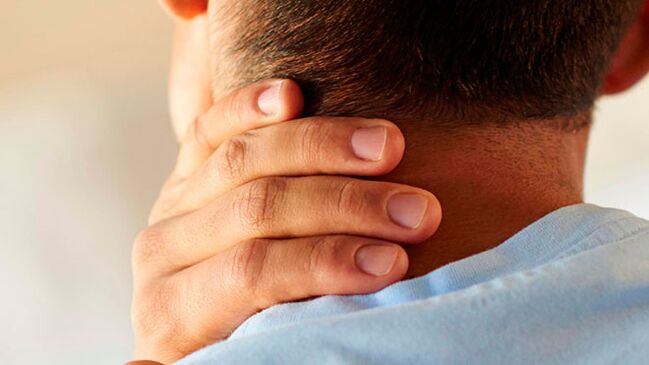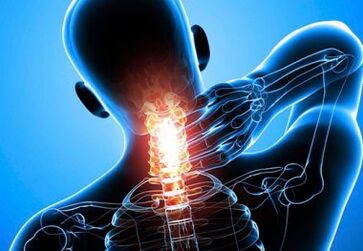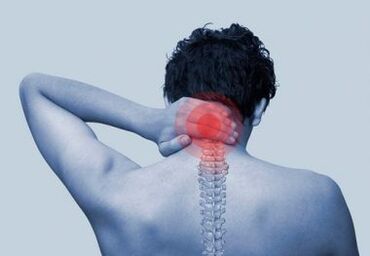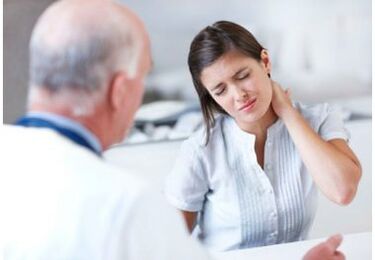Symptoms of cervical osteochondrosis are manifestations of dystrophic changes in cartilage tissue and intervertebral discs. The development of the pathology contributes to the subsidence and deformity of the vertebrae. As a result, the patient experiences pain, dizziness, and nausea.

Osteochondrosis of the cervical spine is accompanied by persistent or recurrent neck pain. This is the most basic symptom of osteochondrosis of the cervix.
The very first symptoms
The cervical spine contains the main blood vessels that feed the brain. Micro-impulses from the main organ and the central nervous system pass through the nerve fibers. The severity of the symptoms depends on the extent of the disease and individual characteristics. In the case of cervical osteochondrosis, the plates with a damping function are negatively affected by:
- The structure changes.
- The growths are formed in the form of tassels due to the growth of osteochondrosis bone tissue. As a result, the blood supply deteriorates and the nerve fibers fail.
The first symptoms of the disease are not expressed.

With the further development of osteochondrosis in the neck, intense pain is observed - the main symptom. During the movements, the discomfort increases, muscle tension occurs.
Different categories of people are at risk. The process is determined by factors that provoke the development of cervical osteochondrosis:
- sedentary lifestyle;
- overweight;
- concomitant pathologies - scoliosis, rheumatism;
- excessive physical activity;
- spinal cord injury.
The main symptoms are in the late stages of the development of osteochondrosis of the neck
Changes in cartilage tissue manifest in the form of signs, the severity of which depends on the severity of the dystrophic disorders. Processes can lead to the failure of any internal system in the body:
- Compression of nerve endings is characterized by symptoms in the form of osteochondrosis neuralgia. Neurological diseases can occur when the spinal cord is constricted. Bone growths at the nerve roots partially or completely immobilize the vertebrae, leading to their fusion. A disappearance of sensitivity is observed.
- Compression of the main and peripheral blood vessels causes a lack of proper blood circulation. Oxygen starvation occurs, heart function deteriorates. Symptoms of the type of cervical osteochondrosis: frequent migraine, increase in blood pressure, incoordination, vascular dystonia, respiratory dysfunction. There may be problems with hearing or vision.
External manifestations of cervical osteochondrosis
External symptoms are characterized by a variety of damage to the body. Patients do not complain of deterioration in general well-being in first-stage pathology. To prevent the development of the disease, it is recommended to live an active lifestyle, swim and perform health-enhancing exercises.

The sensation in second-stage cervical osteochondrosis is characterized by pain syndrome, which leads to stiffness of movements.
The feeling of discomfort can be localized in different areas of the spine. Patient performance decreases. Compression of the arteries causes general weakness, migraine. His decisions, head turns, increase the discomfort in osteochondrosis.
The third stage of the disease is defined by more pronounced symptoms: when the abnormal area is felt, sharp pain and immobility are experienced, the movements are characterized by crackling, dizziness, nausea. The condition manifests as loss of consciousness, the patient feels a lump in his throat. Violation of blood circulation leads to an increase in blood pressure and hypertension. Numbness of the upper limbs occurs.
The fourth phase is determined by the deterioration of the condition. In advanced forms of cervical osteochondrosis, the patient may be disabled. The main symptom is immobilization of the cervical vertebrae. The compression of the arteries and nerve fibers reaches a maximum level, which manifests itself in the form of tinnitus, visual impairment, hearing loss. They violate speech - numbness of the tongue, loss of coordination.
Treatment of osteochondrosis localized in the cervical region is performed using conservative therapies using drugs.
The doctor prescribes physiotherapy and health-improving exercises. In order to eliminate the pain syndrome, a course of restorative massage is recommended in case of worsening of the pathology.
Internal symptoms and manifestations of osteochondrosis in the cervical spine
Internal symptoms are characterized by changes in the structure of cartilage tissue in osteochondrosis:
- Stage I manifestation of chondrosis. The physiological structure of the spine is broken down. The location of the intervertebral discs narrows due to lack of fluid. Muscle hypertension occurs.
- II of osteochondrosis of the neck. Its section is determined by the thinning of the intervertebral discs, their height decreases, which increases the load on the musculoskeletal system. The result is pain.
- III. Stage Cartilage deformation occurs, bone tissue proliferation is observed, intervertebral hernias are formed, protrusion occurs. Cases of disc failure were recorded. The symptoms of the condition are characterized by severity. Arthrosis begins to progress.
- ARC. Section: Complete destruction of discs between vertebrae by further replacement of cavities with bones or connective tissue. The process leads to the formation of accumulations.

To prevent the development of the disease, it is recommended to perform regular home exercises aimed at strengthening the muscle ligament in osteochondrosis. Special medications, ointments and injections are prescribed to relieve pain. Folk remedies are used in the form of compresses and bandages.
Are the symptoms different between women and men?
The neck is the most mobile part of the musculoskeletal system, it has 7 vertebrae. The division begins at the pectoralis and connects to the skull. In women, the signs of cervical osteochondrosis do not differ from the manifestations of pathology in men. According to statistics, women are more prone to developing the disease, which is due to the anatomical structure, possible pregnancy.
The course of the disease depends on concomitant conditions, hormonal levels, symptoms, and other factors.
| Differences | Men | Women |
| Cross section of the spine | Bigger size. | Less. |
| System functions | The body is under constant stress. Fractures are less common due to more developed muscles. | It adapts better to loads. Osteochondrosis, curvature in the form of scoliosis, osteoporosis are often diagnosed. |
| Clinical picture | The condition is characterized by stability. Lower pain threshold. Patients cannot clearly describe all the signs. | The symptoms are pronounced. Patients clearly articulate complaints. |
| Age changes | The board is not subject to the restructuring of internal systems for 45-50 years. | Changes are observed in pregnancy after 45 hormonal changes. Pain, numbness of the hands may occur. |
Carrying the fetus may cause symptoms:
- progression of cervical, lumbar osteochondrosis;
- stinging of nerve endings;
- incidence of cardiovascular problems;
- stiffness of movement.
Be sure to check out a excerpt from the popular health show. This number lists in detail all the main symptoms of cervical osteochondrosis:
Diagnosis of osteochondrosis of the cervical spine
A comprehensive diagnosis of osteochondrosis in the cervical region, taking into account the extent of the disease, the symptoms, is the key to a favorable course of the condition. Various methods are used to make an accurate diagnosis:
- Control. After consultation with a doctor, a visual assessment is made with the parameter - gait, posture. A complete medical history of the patient's symptoms is recorded.
- Radiography is considered an affordable method of examination. It is characterized by the possible occurrence of consequences that affect the overall well-being of the patient. A snapshot of the cervical spine is taken from the base of the skull to the upper chest. The study presents the condition of intervertebral discs.
- Tomography. There are two types: computer and magnetic resonance imaging (MRI). In the first case, a specialist uses an X-ray to make slices using a special device. The resulting image is displayed on the computer screen and a 3D model is executed. The second type of test is based on the work of electromagnetic waves. They take pictures of a specific part of the body layer by layer.

If symptoms of osteochondrosis of the neck are characterized by intense development, you should consult a doctor.
Prevention of osteochondrosis of the neck
To prevent the disease, it is recommended to lead an active lifestyle, perform regular exercises and swim. With an advanced form of pathology, treatment is prescribed, including taking painkillers, to normalize the work of the body’s internal systems.






















